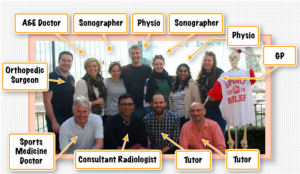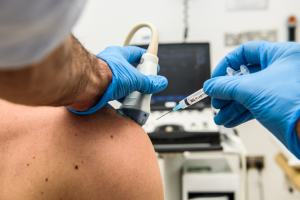
At SMUG we have been teaching ultrasound-guided injections for many years. We now teach the course over 2 days at St Georges Medical School Cadaveric Laboratory in London. The course is always receives excellent feedback from delegates. The Musculoskeletal Sonographers and Injections course attracts clinicians from a variety of professional backgrounds.

Recently we have had more enquiries from sonographers wanting to come on the cadaveric course and asking ‘if I come on the course can I carry out ultrasound guided injections afterwards’.
Unfortunately, like most competency-based questions around ultrasound and ultrasound guided injection there is no simple answer. The key questions are based around insurance, how you attain the drug and competency. I hope this article helps to make this ‘grey’ area a little clearer. This is a just a guideline and local policies within trusts and clinics will vary so you must check with your manager.

Insurance:
Any clinician carrying out ultrasound-guided injections must have the correct insurance in place. Not only that, but they must make sure they have competed the necessary requirements of the course before they start injecting. Clinicians may be able to start injecting, under supervision, before the end of the course but the individual must check this with the course lead and their local manager and supervisor. If a clinician starts injecting before they have completed the necessary components of the course they are NOT insured and are not protected.

Most sonographers are radiographers and are members of the HCPC (Health and Care Professions Council) and SoR (Society of Radiographers). The SoR provide the clinicians public liability insurance. It is responsibility of the practitioner to contact the SoR to ensure that injections are covered under their scope of practice. We would encourage all members to check directly with the SoR when they are extending or changing their scope of practice and to obtain something in writing.


The employer of the individual must also ensure they have adequate employers (‘vicarious’) liability to cover their sonographers carrying out injections.
How you obtain the drugs:
At present sonographers cannot be independent prescribers unlike physiotherapists or podiatrists. This may well change in the near future.
Sonographers can obtain their drug in two ways:
1/ Patient Specific Directive (PSD) – A PSD is the traditional written instruction signed by a doctor, dentist or non-medical prescriber for medicines to be administered to a named patient. The sonographer then carries out the procedure.

2/ Patient Group Directive (PGD). A PGD is a written instruction for the administration of medicine to a group of patients e.g. patients with frozen shoulder, who may not be individually identified before presentation for treatment.
PGD’s essentially provide a legal framework that allows the supply and/or administration of a specified medicine(s), by a named authorised health professionals, to a pre-defined group of patients needing treatment for a condition described in he PGD, without the need for a prescription or an instruction from a prescriber. Using a PGD is not a form of prescribing. In a busy department this is the most convenient method for both the practitioner and the patient. However, a PGD must be agreed and signed on behalf of the authorising body with which a contract and agreement for the provision of those services has been made. For more extensive information on PGD’s here:
SoR also have some information on the website: https://www.sor.org/learning/document-library/supply-administration-and-prescribing-medicines-guidance-and-advice-radiography-workforce/current
Competency:
There is a currently no agreed competency pathway for sonographers to carry out ultrasound guided injections. How a sonographer attains competency depends on the department/clinics local policy. The simplicity and ease of this process is determined by the local support available in the department, particularly the support and supervision of a radiologist, or other medical practitioner. If the sonographer has the close support and regular supervision of a radiologist or medical practitioner and they have supervised sonographers previously then this is a more straight-forward route. If you are starting from the beginning and you are the first sonographer in a department to go through the process then it is likely to be a little more longwinded.

To gain competency we would suggest sonographers attend an accredited post-graduate university based injection course first. These courses are currently available at a number of universities including:
These courses teach ‘unguided’ injection techniques but they provide the theory and practice required to perform musculoskeletal injections safely and effectively. These courses require you to carry out and log 10 assessed injections. This will require the delegate to obtain a clinical supervisor/assessor for the duration of the course and you will not be accepted on the course unless this person is in place. A supervisor must be a clinician with extensive experience of carrying out injections. Ten injections is obviously not enough to be competent at all injections so we suggest you continue with regular mentoring and supervision after you have completed the course, as with any clinical skill.
There are many very experienced and highly reputable sonographers in the UK injecting without such a formal injection course that have been trained and supervised in clinical practice. This will just depend on how much local support can be provided and must be discussed with your line manager. Irrespective of this from a medico-legal (‘belts and braces’) perspective it is recommended that anyone wanting to carry out injections attains a basic university accredited injection course. In the future this may well be a pre-requisite for sonographers to inject.
Essex University are the only university based course that provides a ‘guided’ injection module. One of our SMUG course tutors, Mark Maybury, an Extended Scope Physiotherapist (ESP) is one of the course leads, along with Dr Sue Innes. For more information: https://www1.essex.ac.uk/hhs/documents/cpd/hs974-ultrasound-guided-musculoskeletal-injections.pdf
SMUG Ultrasound Guided Injection Course
At the end of the day an ultrasound guided injection is a motor skills that requires a significant number of hours practicing with expert tuition and the more practice. The SMUG 2-day cadaveric ‘guided’ injection course provides this and is the best way to practice your injection skills in a stress free, relaxed, informal but focussed, fully supported environment. Delegates are taught all upper and lower limb articular and peri-articuar injections over the 2 days and get the opportunity to practice these injections as many times as they like. We have been teaching the guided injection course for over 8 years and between the tutors we have over 40 years of experience. Over the years we have developed the easiest and most effective techniques for all joint and soft tissue injections.
Over the years teaching guided injections we have found that as sonographers already have the required probe skills and anatomical knowledge they develop ‘guided’ injection skills with relative ease. Course delegates have full access to the cadaveric laboratory over the two days (no limited time slots). Delegates experience a steep learning curve on the course irrespective of their clinical background and experience. The cadavers we use on the course are full body ‘soft embalmed’ and have been specially prepared by the team at St Georges. ‘Soft embalmed’ cadavers act and feel just like real patients when performing a guided injection.
Following the course, like the ‘guided’ injection courses, we would suggest you carry out and log 10 supervised ‘guided’ injections under supervision. If you are relatively new to MSK scanning we would advise you attend our Introduction to MSK Imaging to gain a basic level of MSK ultrasound before attending our cadaveric guided injection course to ensure you gain the most out of the course. If you already have MSK experience this is not necessary.
I hope you have found this article useful and I hope to see you on one of our courses soon!
If you have any questions please do not hesitate to contact Chris Myers (Cadaveric guided injection course lead) at info@ultrasoundtraining.co.uk
There is also some useful information at the Society of Radiographers at www.sor.org.
I would like to thank Alison Hall (Consultant Musculoskeletal Sonographer) & Mark Maybury (Physiotherapist & MSK Sonographer) for their guidance on this article.